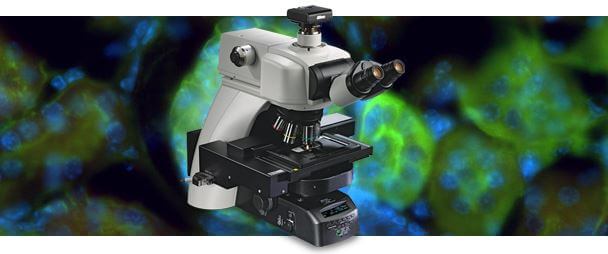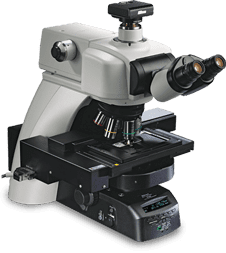

Upright microscope system offering superior optical performance, multi-mode expandability, and advanced motorization capabilities.
A leap forward in research microscopy. See the evolution!
The culmination of years of innovation and optical refinement, Nikon’s Eclipse Ni-E upright research microscope incorporates a revolutionary modular design that allows easy expansion and precise system customization. All-new CFI Plan Apochromat Lambda objectives with Nano Crystal Coat technology yield brighter, higher resolution images with higher transmission rates. Add enhanced widefield and spot laser illumination capabilities with motorized modular components, and you have a truly evolved research microscope that can take on limitless applications.
Maximum System Expandability
Using core technology from Nikon’s renowned Eclipse Ti inverted research microscope, the Ni-E offers versatile
multi-mode system expandability to suit a vast range of imaging possibilities.
The proprietary “stratum structure” design and expandable infinity space enables the addition of multiple turrets, detectors, laser inputs and other accessories.
The Ni-E is also configurable for multiphoton imaging, as well as fixed-stage configurations to meet the demands of neuroscience applications.


.
Advanced Motorization
To meet the need for more versatile experiment techniques, more motorized options, such as filter wheel, high-speed shutter and photoactivation unit, are now available.

Automatic adjustment with objective changeover
Condenser, aperture and field diaphragm, and ND filter are automatically set to the optimal position during objective changeover. In addition, stage XYZ travel amount per handle rotation and parfocal distance deviation correction are automatically adjusted. Microscope settings can also be manually adjusted.
Observation mode changeover
Observation methods such as brightfield, DIC, phase contrast and fluorescence can be set via programmable buttons, enabling changes to be made at the push of a button. This is particularly useful when the same sample is imaged with multiple observation methods.
High-precision motorized focusing
High-precision Z-focus provides accurate height information required for use with confocal laser microscopes. Individual coarse and fine focus knobs provide enhanced ease of operation.
Improved Optical Performance
The Ni-E incorporates a number of Nikon innovations that provide unsurpassed optical performance.

“Fly-Eye” Lens Array
A “fly-eye” lens array is built into the transmitted light illumination optics to ensure uniform brightness to both eyepieces and digital detectors. The “fly-eye” lens is ideally suited to diascopic illumination optical systems.
Noise Terminator
Nikon’s proprietary noise terminator mechanism is employed in the epi- fluorescence cube turret and filter cubes. The S/N ratio has been dramatically improved by thoroughly eliminating stray light in the filter cubes, allowing images of weak fluorescent signals to be captured with high contrast and brightness.
Nano Crystal Coat
This anti-reflective coating consisting of nanometer-size particles is based on semiconductor manufacturing technology and is also used for Nikon camera lenses. The coarse structure with particles arranged in a spongy construction with uniform spaces between them enables extremely low refractive indices.
CFI Plan Apochromat λ Series Objectives
With remarkably high NA, greatly improved transmission in the long wavelength range thanks to Nikon proprietary Nano Crystal Coat, and chromatic aberration correction over 435 to 850 nm, these objectives are ideally suited not only for brightfield and DIC observations but also for fluorescent observations. These lenses allow acquisition of bright and clear images at any wavelength for near-IR imaging and multi-color fluorescence imaging. Because bright images can be captured even with a weak excitation light, damage to a specimen is minimized.
Powerful Digital Imaging Capabilities
The Ni-E can be controlled in conjunction with a Digital Sight series digital camera, facilitating effortless digital imaging. Images can be captured with a dedicated button on the microscope body, the touch panel on the camera control unit, or the software GUI on a PC, depending on your preference.
Image Capture Button
Images can be acquired by simply pressing the image capture button located on the microscope base, without removing your eyes from the eyepieces.

Digital Sight Cameras
A wide array of Nikon digital cameras offering with high sensitivity, high resolution, high speeds and faithful color reproduction are available to meet all research needs and purposes.
DS-L3 Stand-alone Control Unit
The DS-L3 allows the Digital Sight series digital camera to be set up and operated without a PC connection. It also enables image acquisition from a PC through a network. The DS-L3 is firmware based, and therefore will not compromise your facility’s network
NIS-Elements Imaging Software
Nikon’s NIS-Elements imaging software employs a single platform to allow stress-free operations, from image capture through to comprehensive control of camera, microscope and peripheral devices, to image processing, measurement, data management and analysis.

New, Streamlined Design
The Ni series employs a modern, organic design in the microscope wing that adds a gentle beauty while reducing stress during lengthy observations.
When designing the Ni series, Nikon collaborated with Akio Shindate, previously involved in the design of Nikon SLR cameras from the early stage of concept building. Through this collaboration with Shindate, who excels at unique ideas and stylish designs, Nikon has produced innovative new microscopes that combine function with beauty.
Ni-E with Focusing stage
| Optical system | CFI60 infinity optical system |
|---|---|
| Illumination | 12V100W halogen lamp, power supply from control box ABuilt-in fly-eye lensBuilt-in NCB11/ND8/ND32 filters (in/out possible, detachable, one additional filter mountable) and diffuser (in/out not possible, non-detachable)Motorized ND filter unit for light intensity control available as option |
| Controls | Transmitted light on/off switch, intensity control dial (Preset function provided)NCB11/ND8/ND32 filter in/out switchesMotorized control switches (field diaphragm, aperture diaphragm, objective changeover, objective escape, focusreset, fluorescence cube turret, excitation light shutter, optical path changeover, observation mode changeover, microscope status display changeover)Image capture button Ergo controller (option) |
| Focusing | Motorized coaxial coarse/fine focusing Built-in linear encoder, resolution: 0.025µmFocusing stroke (from focuspoint): upward 2 mm, downward 13 mm Escape function as refocusing mechanism |
| Eyepiece lens (F.O.V.) | 10x (22 mm), 10xM photomask (22 mm), 12.5x (16 mm), 15x (14.5 mm), UW10x (25 mm), UW10xM photomask (25 mm) |
| Eyepiece tube (Light distribution) |
Binocular tube, F.O.V. 22 Trinocular tube F, F.O.V. 22/25* (eyepiece/port: 100/0, 0/100) Trinocular tube T, F.O.V. 22/25* (eyepiece/port: 100/0, 20/80, 0/100) Ergonomic binocular tube, F.O.V. 22, inclination angle: 10-30, tube extension up to 40 mm (when DSC port is attached, eyepiece/port: 100/0, 50/50) Quadrocular tilting tube, Motorized quadrocular tilting tube, F.O.V. 22/25*, inclination angle: 15-35 (eyepiece/upper port/rear port: 100/0/0, 0/100/0, 0/0/100)
|
Ni-E with Focusing nosepiece
| Optical system | CFI60 and CFI75 infinity optical systems |
|---|---|
| Illumination | 12V100W halogen lamp, power supply from control box ABuilt-in fly-eye lensBuilt-in NCB11/ND8/ND32 filters (in/out possible, detachable, one additional filter mountable) and diffuser (in/out not possible, non-detachable)Motorized ND filter unit for light intensity control available as option |
| Controls | Transmitted light on/off switch, intensity control dial (Preset function provided)NCB11/ND8/ND32 filter in/out switchesMotorized control switches (field diaphragm, aperture diaphragm, objective changeover, objective escape, focusreset, fluorescence cube turret, excitation light shutter, optical path changeover, observation mode changeover, microscope status display changeover)Image capture button Ergo controller (option) |
| Focusing | Motorized coaxial coarse/fine focusing Built-in linear encoder, resolution: 0.025µmFocusing stroke (from focus point): upward 12 mm, downward 3 mm Escape function as refocusing mechanism |
| Eyepiece lens (F.O.V.) | 10x (22 mm), 10xM photomask (22 mm), 12.5x (16 mm), 15x (14.5 mm), UW10x (25 mm), UW10xM photomask (25 mm) |
| Eyepiece tube (Light distribution) |
Binocular tube, F.O.V. 22 Trinocular tube F, F.O.V. 22/25* (eyepiece/port: 100/0, 0/100) Trinocular tube T, F.O.V. 22/25* (eyepiece/port: 100/0, 20/80, 0/100) Ergonomic binocular tube, F.O.V. 22, inclination angle: 10-30, tube extension up to 40 mm (when DSC port is attached, eyepiece/port: 100/0, 50/50) Quadrocular tilting tube, Motorized quadrocular tilting tube, F.O.V. 22/25*, inclination angle: 15-35 (eyepiece/upper port/rear port: 100/0/0, 0/100/0, 0/0/100)
|